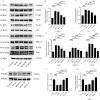Asarinin attenuates bleomycin-induced pulmonary fibrosis by activating PPARγ
- PMID: 37679587
- PMCID: PMC10485066
- DOI: 10.1038/s41598-023-41933-5
Asarinin attenuates bleomycin-induced pulmonary fibrosis by activating PPARγ
Abstract
Idiopathic pulmonary fibrosis (IPF) is a chronic progressive interstitial lung disease that lacks effective treatment modalities. Once patients are diagnosed with IPF, their median survival is approximately 3-5 years. PPARγ is an important target for the prevention and treatment of pulmonary fibrosis. Asarinin is a lignan compound that can be extracted from food plant Asarum heterotropoides. In this study, we investigated the therapeutic effects of asarinin in a pulmonary fibrosis model constructed using bleomycin in mice and explored the underlying mechanisms. Intraperitoneal administration of asarinin to mice with pulmonary fibrosis showed that asarinin effectively attenuated pulmonary fibrosis, and this effect was significantly inhibited by the PPARγ inhibitor GW9662. Asarinin inhibited TGF-β1-induced fibroblast-to-myofibroblast transition in vitro, while GW9662 and PPARγ gene silencing significantly inhibited this effect. In addition, asarinin inhibited not only the canonical Smad pathway of TGF-β but also the non-canonical AKT and MAPK pathways by activating PPARγ. Our study demonstrates that asarinin can be used as a therapeutic agent for pulmonary fibrosis, and that PPARγ is its key target.
© 2023. Springer Nature Limited.
Conflict of interest statement
The authors declare no competing interests.
Figures








Similar articles
-
Zanubrutinib attenuates bleomycin-induced pulmonary fibrosis by inhibiting the TGF-β1 signaling pathway.Int Immunopharmacol. 2022 Dec;113(Pt A):109316. doi: 10.1016/j.intimp.2022.109316. Epub 2022 Oct 15. Int Immunopharmacol. 2022. PMID: 36252483
-
Deficiency of HtrA3 Attenuates Bleomycin-Induced Pulmonary Fibrosis Via TGF-β1/Smad Signaling Pathway.Lung. 2023 Apr;201(2):235-242. doi: 10.1007/s00408-023-00608-8. Epub 2023 Feb 24. Lung. 2023. PMID: 36823409
-
Curdione ameliorates bleomycin-induced pulmonary fibrosis by repressing TGF-β-induced fibroblast to myofibroblast differentiation.Respir Res. 2020 Feb 19;21(1):58. doi: 10.1186/s12931-020-1300-y. Respir Res. 2020. PMID: 32075634 Free PMC article.
-
Fedratinib Attenuates Bleomycin-Induced Pulmonary Fibrosis via the JAK2/STAT3 and TGF-β1 Signaling Pathway.Molecules. 2021 Jul 26;26(15):4491. doi: 10.3390/molecules26154491. Molecules. 2021. PMID: 34361644 Free PMC article.
-
Baricitinib Attenuates Bleomycin-Induced Pulmonary Fibrosis in Mice by Inhibiting TGF-β1 Signaling Pathway.Molecules. 2023 Feb 27;28(5):2195. doi: 10.3390/molecules28052195. Molecules. 2023. PMID: 36903446 Free PMC article.
Cited by
-
Exploring the Mechanism of Action and Potential Targets of Saorilao-4 Decoction in the Treatment of Pulmonary Fibrosis in Rats by Metabolomics.Food Sci Nutr. 2025 Jan 31;13(2):e4633. doi: 10.1002/fsn3.4633. eCollection 2025 Feb. Food Sci Nutr. 2025. PMID: 39898125 Free PMC article.
-
Progress of cGAS-STING signaling pathway-based modulation of immune response by traditional Chinese medicine in clinical diseases.Front Immunol. 2024 Dec 16;15:1510628. doi: 10.3389/fimmu.2024.1510628. eCollection 2024. Front Immunol. 2024. PMID: 39737190 Free PMC article. Review.
-
It takes two peroxisome proliferator-activated receptors (PPAR-β/δ and PPAR-γ) to tango idiopathic pulmonary fibrosis.Respir Res. 2024 Sep 23;25(1):345. doi: 10.1186/s12931-024-02935-7. Respir Res. 2024. PMID: 39313791 Free PMC article.
-
Spatial and phenotypic heterogeneity of resident and monocyte-derived macrophages during inflammatory exacerbations leading to pulmonary fibrosis.Front Immunol. 2024 Jul 19;15:1425466. doi: 10.3389/fimmu.2024.1425466. eCollection 2024. Front Immunol. 2024. PMID: 39100672 Free PMC article.
-
Comparison of the Results of Modeling Pulmonary Fibrosis in Sprague Dawley Rats by Intratracheal Administration of Bleomycin in the Form of Sulfate and Chloride at a Dose of 3 mg/kg.Pharmaceuticals (Basel). 2024 Oct 11;17(10):1360. doi: 10.3390/ph17101360. Pharmaceuticals (Basel). 2024. PMID: 39459000 Free PMC article.
References
Publication types
MeSH terms
Substances
LinkOut - more resources
Full Text Sources

